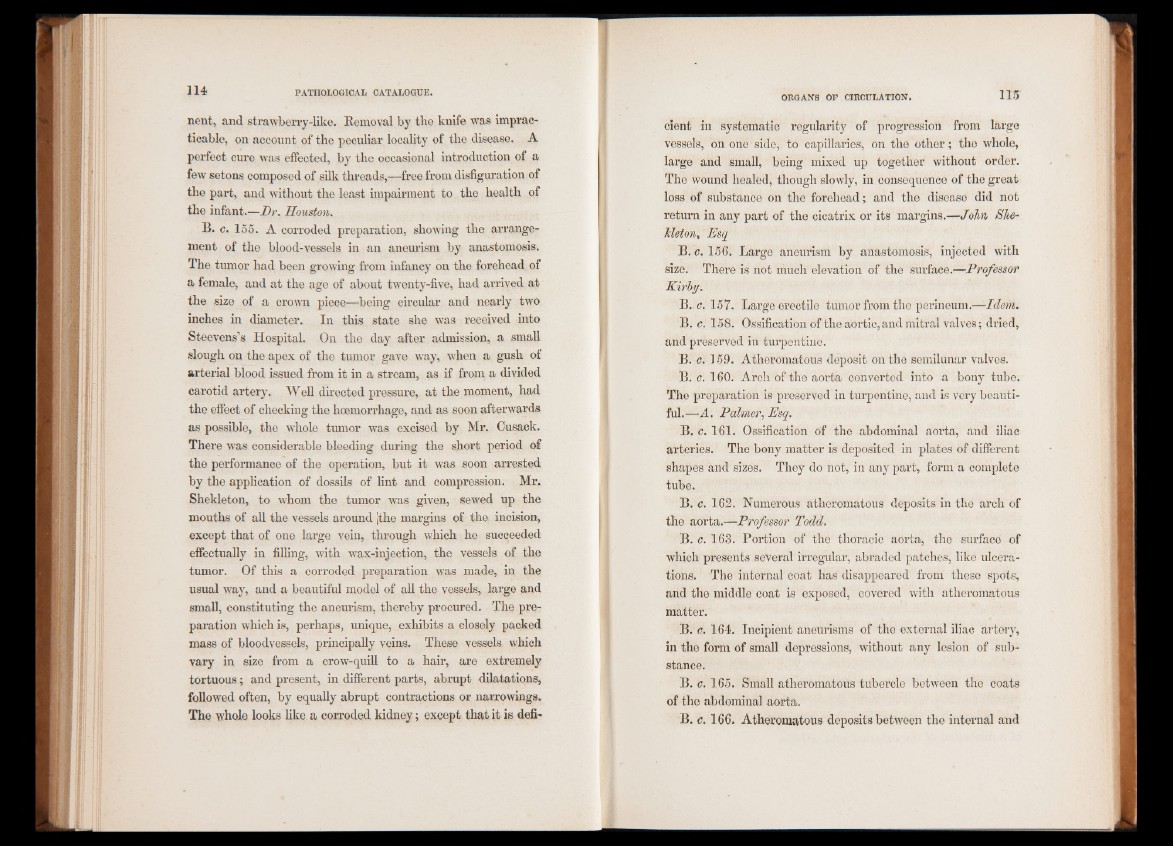
nent, and strawberry-like. Removal by the knife was impracticable,
on account of the peculiar locality of the disease. A
perfect cure was effected, by the occasional introduction of a
few setons composed of silk threads,—free from disfiguration of
the part, and without the least impairment to the health of
the infant.—Dr. Houston.
B. c. 155. A corroded preparation, showing the arrangement
of the blood-vessels in an aneurism by anastomosis.
The tumor had been growing from infancy on the forehead of
a female, and at the age of about twenty-five, had arrived at
the size of a crown piece—being circular and nearly two
inches in diameter. In this state she was received into
Steevens’s Hospital. On the day after admission, a small
slough on the apex of the tumor gave way, when a gush of
arterial blood issued from it in a stream, as if from a divided
carotid artery. Well directed pressure, at the moment, had
the effect of checking the hoemorrhage, and as soon afterwards
as possible, the whole tumor was excised by Mr. Cusack.
There was considerable bleeding during the short period of
the performance of the operation, but it was soon arrested
by the application of dossils of lint and compression. Mr.
Shekleton, to whom the tumor was given, sewed up the
mouths of all the vessels around jthe margins of the incision,
except that of one large vein, through which he succeeded
effectually in filling, with wax-injection, the vessels of the
tumor. Of this a corroded preparation was made, in the
usual wray, and a beautiful model of all the vessels, large and
small, constituting the aneurism, thereby procured. The preparation
which is, perhaps, unique, exhibits a closely packed
mass of bloodvessels, principally veins. These vessels which
vary in size from a crow-quill to a hair, are extremely
tortuous; and present, in different parts, abrupt dilatations,
followed often, by equally abrupt contractions or narrowings.
The whole looks like a corroded kidney; except that it is deficient
in systematic regularity of progression from large
vessels, on one side, to capillaries, on the other ; the whole,
large and small, being mixed up together without order.
The wound healed, though slowly, in consequence of the great
loss of substance on the forehead; and the disease did not
return in any part of the cicatrix or its margins.—Jolm She-
Meton, Esq
B. c. 156. Large aneurism by anastomosis, injected with
size. There is not much elevation of the surface.—Professor
Kirby.
B. c. 157. Large erectile tumor from the perineum.—Idem.
B. c. 158. Ossification of the aortic, and mitral valves; dried,
and preserved in turpentine.
B. c. 159. Atheromatous deposit on the semilunar valves.
B. c. 160. Arch of the aorta converted into a bony tube.
The preparation is preserved in turpentine, and is very beautiful.—
A. Palmer, Esq.
B. c. 161. Ossification of the abdominal aorta, and iliac
arteries. The bony matter is deposited in plates of different
shapes and sizes. They do not, in any part, form a complete
tube.
B. c. 162. Numerous atheromatous deposits in the arch of
the aorta.—Professor Todd.
B. c. 163. Portion of the thoracic aorta, the surface of
which presents several irregular, abraded patches, like ulcerations.
The internal coat has disappeared from these spots,
and the middle coat is exposed, covered with atheromatous
matter.
B. c. 164. Incipient aneurisms of the external iliac artery,
in the form of small depressions, without any lesion of substance.
B. c. 165. Small atheromatous tubercle between the coats
of the abdominal aorta.
B. c. 166. Atheromatous deposits between the internal and